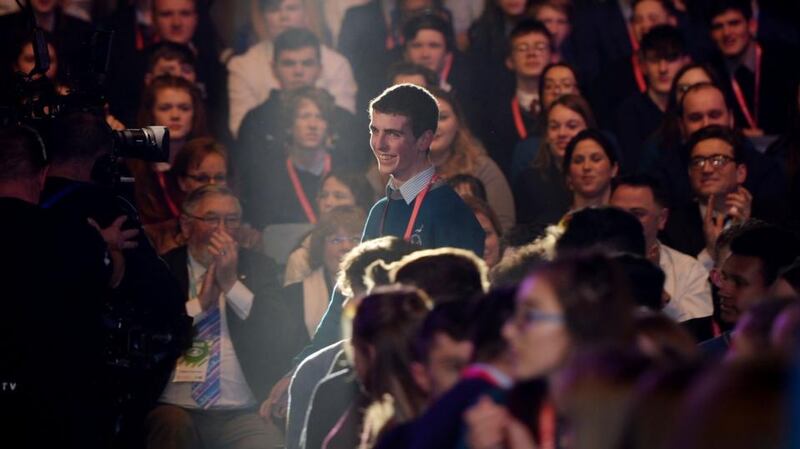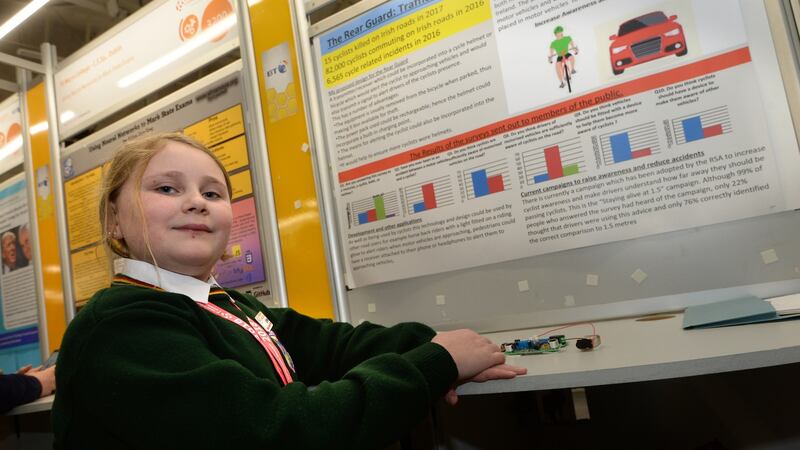If ever you needed reassurance that innovation is thriving in Ireland, a tour of the BT Young Scientist and Technology Exhibition would have provided it in ample quantities.
The exhibition was thronged with thousands of students eager to follow in the footsteps of Patrick Collison, the Stripe co-founder who entered the exhibition in 2004 with a project on artificial intelligence. That earned him a runner-up position, but in 2005 he returned with Croma, a programming language, and came home as the winner.
This year it was neural networks, machine learning, artificial intelligence and augmented reality that were the focus of many projects. From using machine learning to help improve the treatment of molar cancer to the translation of Spanish poems to English, to exploring the ability of neural networks to represent music, the technology was everywhere,
Adaptive network
That could include the classroom. In the future, State exams could be under the control of neural networks – to a certain extent at least. That was the topic explored by Aidan Dowling from St Mary’s College in Rathmines. He developed a method of correcting State exams using neural networks. “It does this by analysing sample answers provided by teachers,” he explained. “You enter your exams on a website as a student, and the system corrects them using an adaptive neural network.”
The 16-year-old is a former member of Coder Dojo, joining the coding club when he was in fifth class. He left in first year, but technology remained a general interest, eventually leading to this project.

About 50 students have been test subjects for his project, and the results were exactly what he was hoping for. “There was about 93 per cent accuracy on average,” he said. “Some of the most accurate questions were sentence-based ones.”
The only catch? The exam has to be completed on a computer, but most State exams are written. That may not be such an issue in the future, though.
Computer science is entering the school curriculum this year, with the first State exam in the subject set for 2020. Those exams, naturally, will be completed on computers. “That’s really where this is going,” said Dowling. “It’s where almost everything is going with technology, and if it is the next step, I’d love to be at the forefront of that, exploring the methods that can done and the ways people are going about it.”
Those who have been using Swiipe, a news app available for iOS and Android, would be familiar with the name Alex Goodison. The teenager from Coláiste Iósaef in Limerick developed the app, billed as a Tinder for news, last year. This year, though, he is turning his attention to fake news stories and how to deal with the growing problem.
“I felt I needed to provide my users with the authentic news; Filter, my algorithm, aims to provide that,” he said. The algorithm takes the article, splits it up into different components and analyses each one separately. For example, article length: Goodison said his research found that fake news articles typically had less than 270 words, with genuine articles stretching to about 500. The algorithm examines more than 12components and then adds the scores up. The highest possible total is 91; the closer to that number, the more authentic the article is deemed to be.
Goodison said his interest in technology was fostered from a young age, with his father – a programmer – getting him to build websites from the age of seven. “I always wanted to make an app,” he said. “This is the result.” He plans to put Filter into his app, building its reputation as a source for legitimate news. Then he will release the algorithm to the community so everyone can benefit, and fake news may soon be a thing of the past.
With bitcoin and digital currencies the hot topic of the moment, it was no surprise to see at least one project devoted to the topic. But Patrick Sheridan, from Meánscoil na Mbráithre in Co Clare, took a different angle. He was investigating the energy impact of cryptocurrency mining in his project, examining the feasibility of mining the digital coins using renewable-energy sources.
Cot deaths
While there were plenty of software projects in the technology section, there were also a number of hardware projects too.
One project that garnered a bit of attention was the Cot Death Eliminator. It aims to help reduce sudden infant death syndrome by regulating a baby’s temperature, using sensors, fans and water pumps to cool a cot. The trio behind the project – Niall Black, Orla McNaughton and Ciarán Cairns – may try to develop it into a commercial product.
“Before we came here we had no intentions of developing it any further, but so many people have said, from their previous experience, it’s something they would be interested in buying,” said Orla. “I think now we have to look into developing it and see what more we can do, if it is a possibility to bring it and make it into something people can buy.”

For 12-year-old Lily Eyers, the inspiration for her project was personal. “I was knocked off my bike when a car got too close and broke my arm,” she explained. “I thought: ‘How could I make cyclists more aware of motorists, and motorists more aware of cyclists?’” Rear Guard was the product of that thought process, a traffic-alert system for bikes that includes an emitter, a receiver and a sounder.
The emitter sends ultrasonic waves that are detected by the receiver, and when an obstacle is detected it triggers the alarm to warn the cyclist. The good news is Eyers has tested it, and it works, hopefully preventing any more injuries in the future.
Eyers is another Coder Dojo member, but her interest in technology began much earlier, at age six. “My grandad was a scientist, so we used to talk a lot about the engineering that he would do at Pfizer, so I got into it that way,” she said.
Among the smart milking solutions and a modular car-safety system, there was Smart Desk, a learning tool aimed at children with dyscalculia to learn numbers with visual, auditory and kinaesthetic methods. Creators Ellen Martin and Rachel McAuley are hoping that it could help children with the condition to be diagnosed at an earlier stage in future, allowing them to get the additional help they need.
While the eventual winner of the 2018 BT Young Scientist and Technology Exhibition didn’t come from the technology section, there is plenty of hope for the future of Ireland’s Stem sector.





















